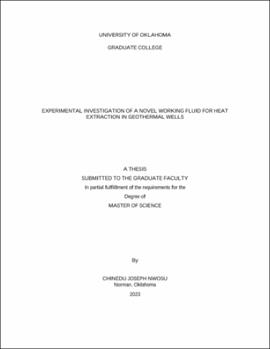| dc.description.abstract | The exponential increase in the global atmospheric carbon dioxide has spurred research interest in the exploration and maximization of renewable energy exploits. This interest has in turn inspired the growth of the geothermal industry and has provided a great opportunity for the repurposing of inactive wells in the Midwest, Northeast and South region of the United States as these regions have been marked with significant carbon dioxide emissions. Despite the created opportunities, these regions are faced with a limitation of low enthalpy geothermal resources, which makes it challenging to extract large amount of heat energy without drilling deeper, thus it is pertinent to explore suitable geothermal primary working fluids which can maximize the heat extraction at these regions with low to medium enthalpy geothermal resources.
Conventionally, water is utilized as the geothermal primary working fluid, however, it is described by its high rate of corrosion, low boiling point and its high critical conditions. Studies have suggested that the high critical conditions of water poise a challenge to the rate of heat transfer, hence, supercritical carbon dioxide (CO2) has been suggested as a potential geothermal working fluid due its favorable properties, such as its low viscosity, low specific heat capacity, and low critical conditions. However, due to the high purchasing cost of CO2, additional costs associated with its insulation around the production well sections, and its limited application to low reservoir temperatures from research studies, it has constrained utilization. Molten salts asides from being relatively cheap have been reported to have excellent heat transfer fluid properties such as good thermal stability at high temperatures, low corrosion rates as it has been described to be a strong passivating agent with the materials used in the transfer of heat, and low vapor pressures as it has strong intermolecular forces which enables the unease to evaporation, thus high boiling point. These properties can present significant benefits when water is being beneficiated with molten salts, particularly nitrate salts as the passivation agent in nitrate salts could result in a reduction of the rate of corrosion in the resulting solution. The low vapor pressure of the salt could also extend the useful operating liquid temperature of the solution above the boiling point of water. This has the overall benefit of retaining or increasing the heat transfer efficiency of the resultant solution.
In this study, a novel working fluid formulated with molten nitrate salt was experimentally investigated for heat extraction in geothermal wells. A corrosion immersion test was performed to compare the rate of corrosion between the proposed novel fluid and water. Additionally, scanning electron microscopy (SEM) and energy dispersive X-ray spectroscopy (EDS) was utilized to validate the passivating property of the novel fluid, which led to a reduction in the corrosion rate when compared to water. The effect of the novel fluid and water on the mineralogy of a known rock sample was further examined using X-ray Diffraction, SEM-EDS, and Fourier transform infrared (FTIR) to determine changes in the mineral spectrum of the rock sample. Finally, a heat transfer setup was developed and used to investigate the convective heat transfer coefficient and the thermal energy generated for the different working fluids at various testing conditions. Comparative analysis was further conducted to determine the effect of fluid properties and operating conditions on the heat transfer coefficient and the thermal energy generated.
The findings from this research study illustrate the significant benefits of the developed novel working fluid compared to water as the novel fluid exhibited favorable thermal properties yielding more thermal energy generation. The novel fluid was observed to reduce the rate of corrosion by over 30% and 60% at 77◦F and 150◦F when compared with water across all tested aging time. Generally, it was observed that the temperature effect on viscosity as well as changes in the flow rate, significantly affected the convective heat transfer coefficient while the thermal energy was observed to be significantly affected by the fluid differential temperature, the flow rate, and the specific heat capacity. | en_US |
